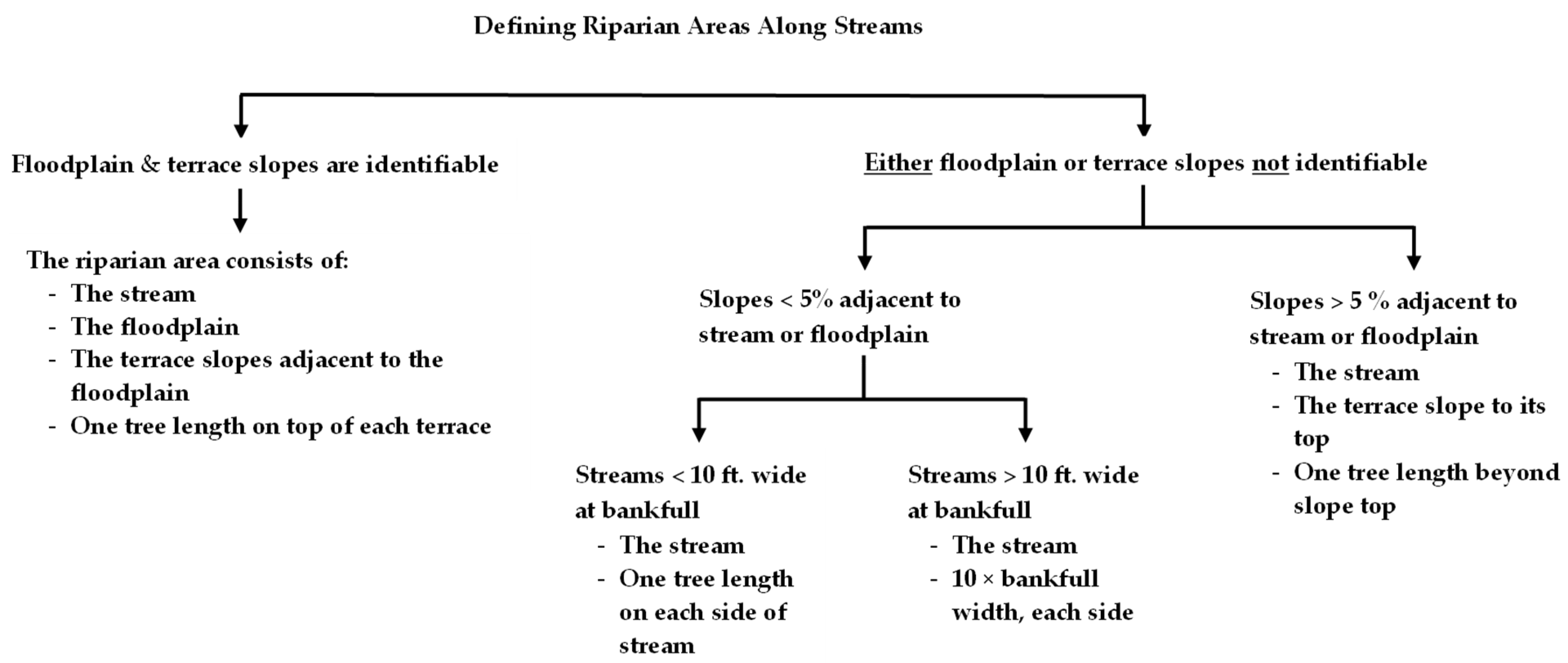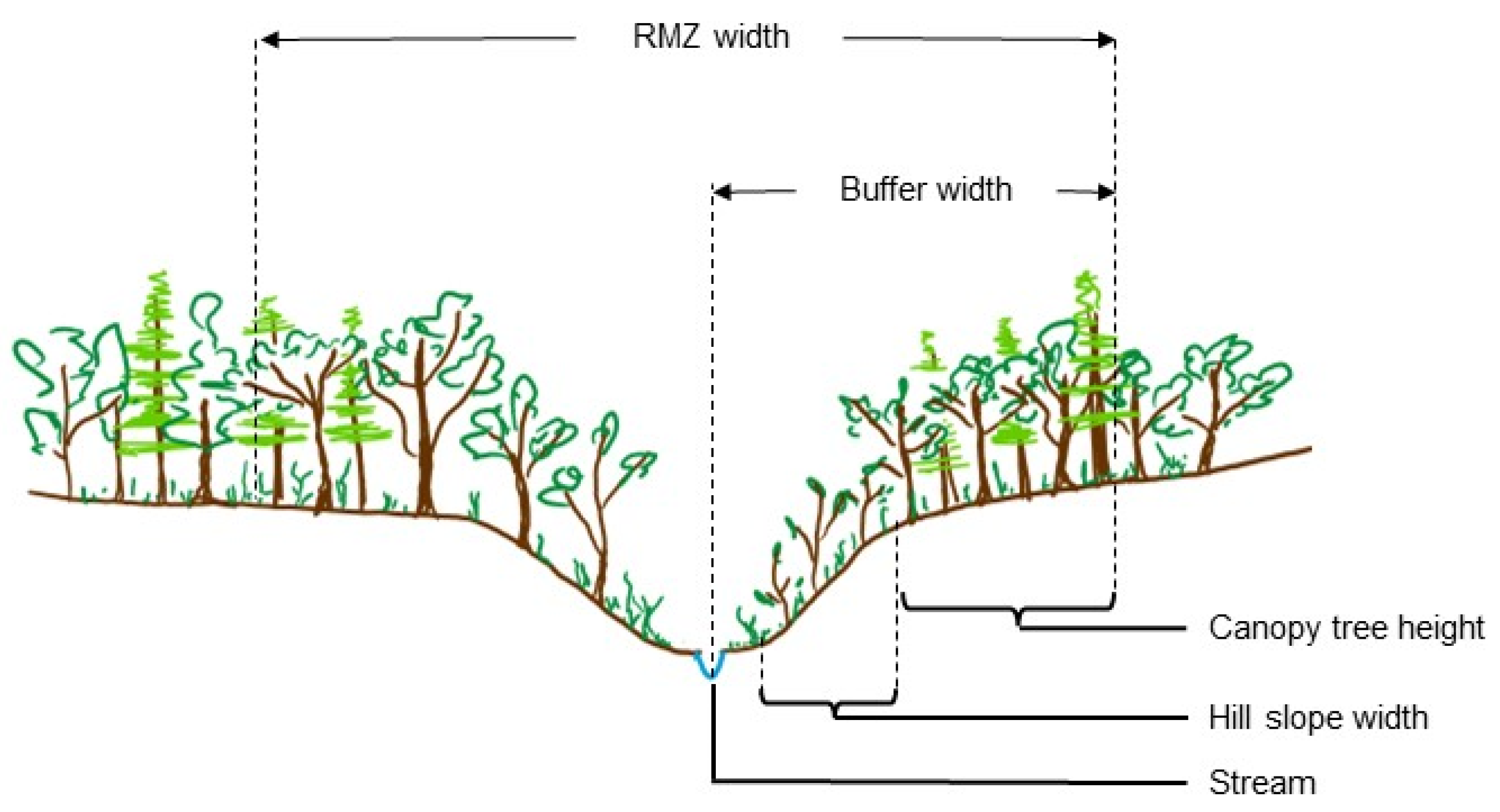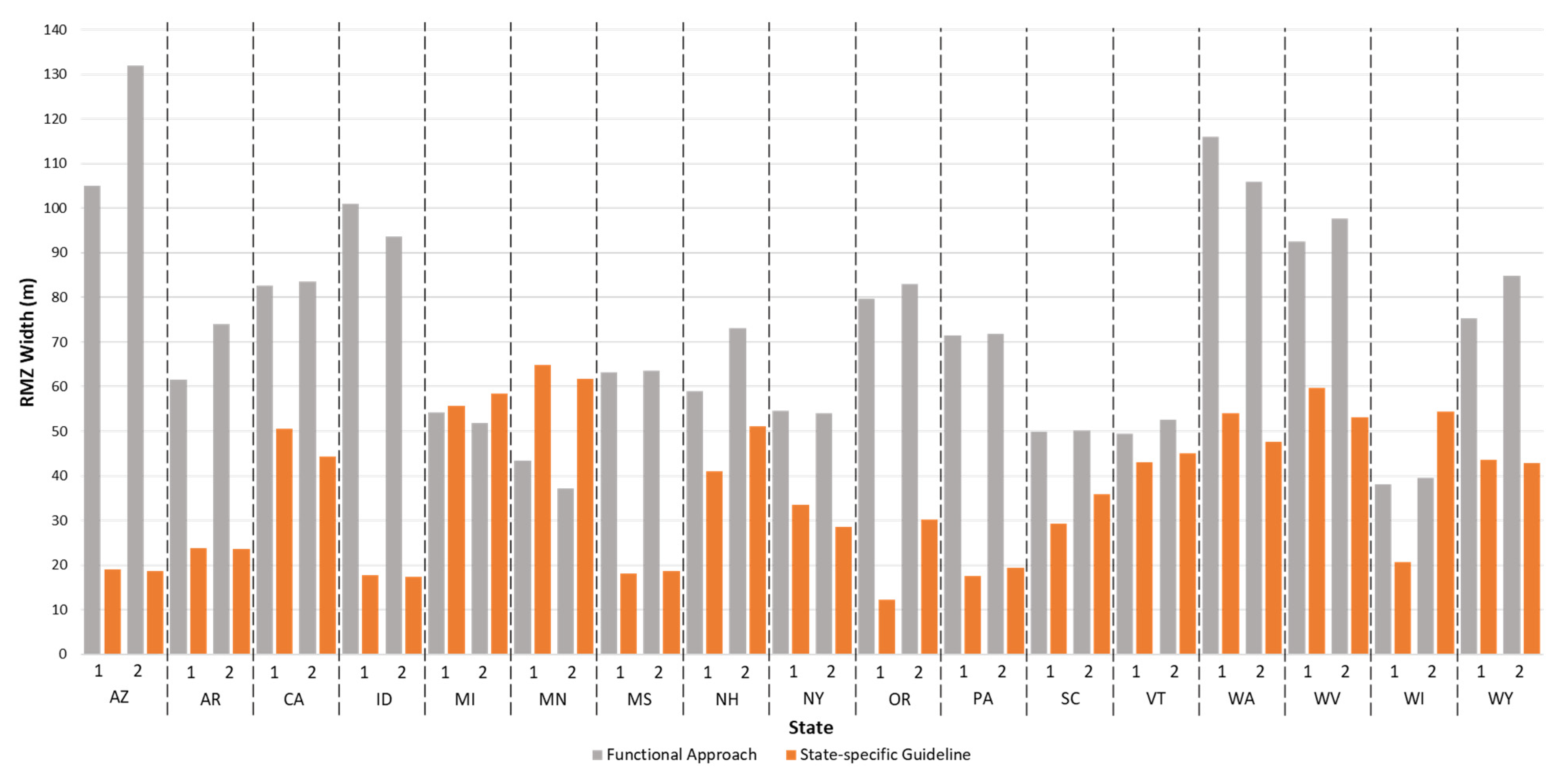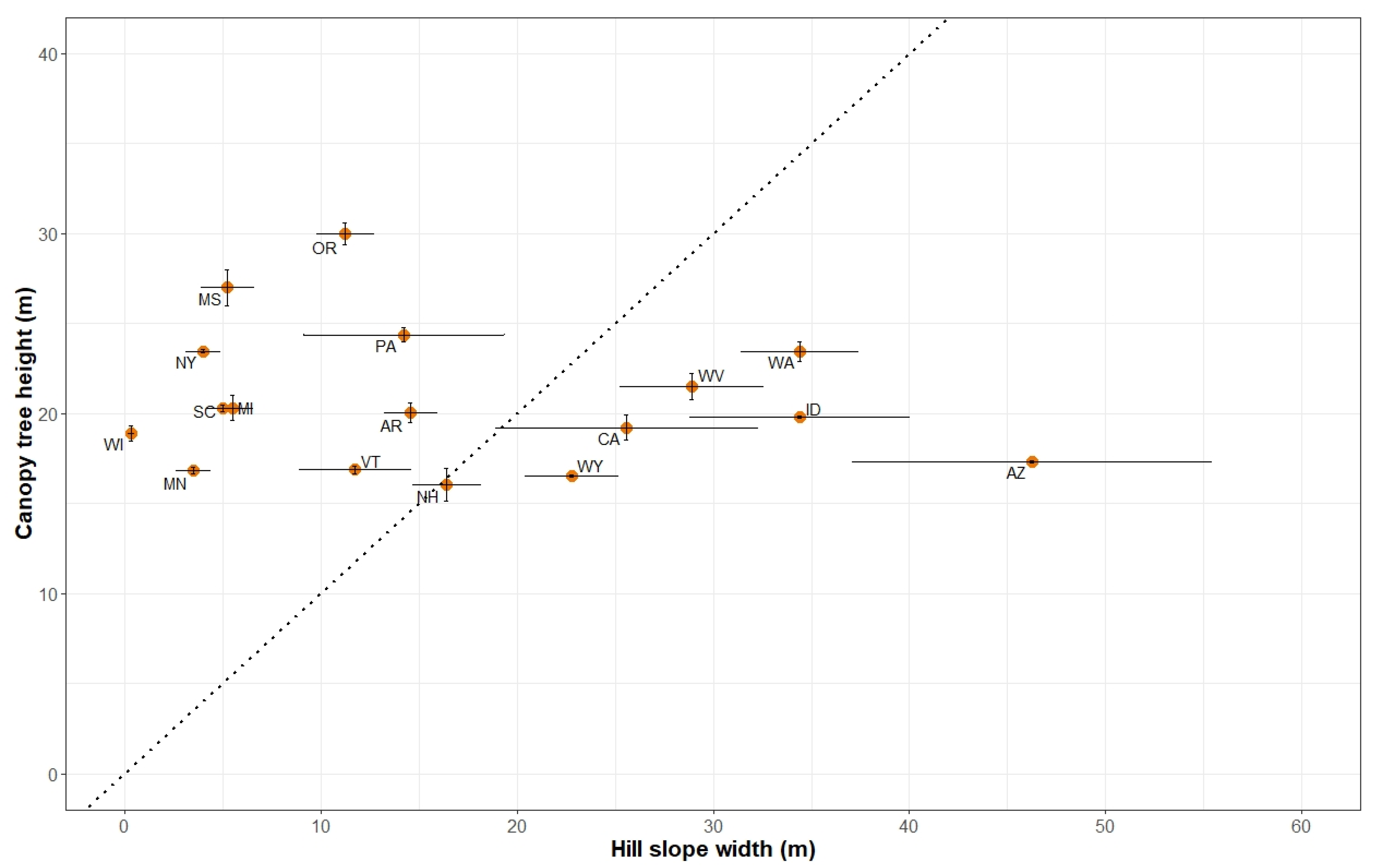Applying the “Goldilocks Rule” to Riparian Buffer Widths for Forested Headwater Streams across the Contiguous U.S.—How Much Is “Just Right”?
Abstract
:1. Introduction
2. Materials and Methods
2.1. Study Design
2.2. Data Sources
2.3. Data Analysis
2.3.1. Drainage Density
2.3.2. Functional Riparian Buffer Delineations
2.3.3. State-Specific RMZ Delineation
2.3.4. Standardizing RMZs and Calculating RMZ Widths
2.3.5. Comparing Land Area Differences between Functional and State-Specific RMZ Widths
2.3.6. Proportion of RMZs within a Watershed
3. Results
3.1. Drainage Density
3.2. Functional RMZ Width Differences across States
3.3. State-Specific RMZ Width Differences across States
3.4. Comparison of Land Area Allocation between a Functional RMZ and a State-Specific RMZ
3.5. Riparian Buffer Areas in Watersheds
4. Discussion
4.1. State-Wide Differences in Functional RMZ Delineations
4.2. Comparing State Prescribed RMZs with Functional RMZs
4.3. Proportion of RMZs in Watersheds
4.4. Implications for Forest Managers
4.5. Study Limitations
5. Conclusions
Supplementary Materials
Author Contributions
Funding
Data Availability Statement
Conflicts of Interest
References
- Shreve, R.L. Statistical Properties of Stream Lengths. J. Geol. 1969, 77, 397–414. [Google Scholar] [CrossRef]
- Naiman, R.J.; Décamps, H.; McClain, M.E. Riparia: Ecology, Conservation, and Management of Streamside Communities; Elsevier Academic Press: Cambridge, MA, USA, 2005; ISBN 9780080470689. [Google Scholar]
- Opperman, J.J.; Moyle, P.B.; Larson, E.W.; Florsheim, J.L.; Manfree, A.D. Floodplains. Processes and Management for Ecosystems; University of California Press: Oakland, CA, USA, 2017. [Google Scholar]
- Baker, M.E.; Weller, D.E.; Jordan, T.E. Effects of Stream Map Resolution on Measures of Riparian Buffer Distribution and Nutrient Retention Potential. Landsc. Ecol. 2007, 22, 973–992. [Google Scholar] [CrossRef]
- Brooks, R.T.; Colburn, E.A. Extent and Channel Morphology of Unmapped Headwater Stream Segments of the Quabbin Watershed, Massachusetts. JAWRA J. Am. Water Resour. Assoc. 2011, 47, 158–168. [Google Scholar] [CrossRef]
- Elmore, A.J.; Julian, J.P.; Guinn, S.M.; Fitzpatrick, M.C. Potential Stream Density in Mid-Atlantic U.S. Watersheds. PLoS ONE 2013, 8, e74819. [Google Scholar] [CrossRef] [PubMed]
- Binkley, D.; Brown, T.C. Forest Practices as Nonpoint Sources of Pollution in North America. J. Am. Water Resour. Assoc. 1993, 29, 729–740. [Google Scholar] [CrossRef]
- Phillips, M.J.; Blinn, C.R. Best Management Practices Compliance Monitoring Approaches for Forestry in the Eastern United States. Water Air Soil Pollut. Focus 2004, 4, 263–274. [Google Scholar] [CrossRef]
- Sweeney, B.W.; Newbold, J.D. Streamside Forest Buffer Width Needed to Protect Stream Water Quality, Habitat, and Organisms: A Literature Review. JAWRA J. Am. Water Resour. Assoc. 2014, 50, 560–584. [Google Scholar] [CrossRef]
- Lakel, W.A.; Aust, W.M.; Bolding, M.C.; Dolloff, C.A.; Keyser, P.; Feldt, R. Sediment Trapping by Streamside Management Zones of Various Widths after Forest Harvest and Site Preparation. For. Sci. 2010, 56, 541–551. [Google Scholar]
- Ward, J.M.; Jackson, C.R. Sediment Trapping Within Forestry Streamside Management Zones: Georgia Piedmont, USA. JAWRA J. Am. Water Resour. Assoc. 2004, 40, 1421–1431. [Google Scholar] [CrossRef]
- Chizinski, C.J.; Vondracek, B.; Blinn, C.R.; Newman, R.M.; Atuke, D.M.; Fredricks, K.; Hemstad, N.A.; Merten, E.; Schlesser, N. The Influence of Partial Timber Harvesting in Riparian Buffers on Macroinvertebrate and Fish Communities in Small Streams in Minnesota, USA. For. Ecol. Manag. 2010, 259, 1946–1958. [Google Scholar] [CrossRef]
- Jackson, R.C.; Batzer, D.P.; Cross, S.S.; Haggerty, S.M.; Sturm, C.A. Headwater Streams and Timber Harvest: Channel, Macroinvertebrate, and Amphibian Response and Recovery. For. Sci. 2007, 53, 356–370. [Google Scholar]
- Lee, P.; Smyth, C.; Boutin, S. Quantitative Review of Riparian Buffer Width Guidelines from Canada and the United States. J. Environ. Manag. 2004, 70, 165–180. [Google Scholar] [CrossRef] [PubMed]
- Jayasuriya, M.T.; Stella, J.C.; Germain, R.H. Can Understory Plant Composition and Richness Help Designate Riparian Management Zones in Mesic Headwater Forests of the Northeastern United States? J. For. 2021, 119, 574–588. [Google Scholar] [CrossRef]
- Blinn, C.R.; Kilgore, M.A. Riparian Management Practices: A Summary of State Guidelines. J. For. 2001, 99, 11–17. [Google Scholar]
- Castelle, A.J.; Johnson, A.W. Riparian Vegetation Effectiveness; National Council for Air and Stream Improvement, Inc.: Cary, NC, USA, 2000. [Google Scholar]
- Jayasuriya, M.T. The Effects Of Riparian Management Zone Delineation On Timber Value And Ecosystem Services In Diverse Forest Biomes Across The United States. Ph.D. thesis, The State University of New York College of Environmental Science and Forestry, Syracuse, NY, USA, 2020. [Google Scholar]
- Cristan, R.; Michael Aust, W.; Chad Bolding, M.; Barrett, S.M.; Munsell, J.F. National Status of State Developed and Implemented Forestry Best Management Practices for Protecting Water Quality in the United States. For. Ecol. Manag. 2018, 418, 73–84. [Google Scholar] [CrossRef]
- Bren, L.J. The Geometry of a Constant Buffer-Loading Design Method for Humid Watersheds. For. Ecol. Manag. 1998, 110, 113–125. [Google Scholar] [CrossRef]
- Tomer, M.D.; James, D.E.; Isenhart, T.M. Optimizing the Placement of Riparian Practices in a Watershed Using Terrain Analysis. J. Soil Water Conserv. 2003, 58, 198–206. [Google Scholar]
- Tiwari, T.; Lundström, J.; Kuglerovà, L.; Laudon, H.; Öhman, K.; Ågren, A.M. Cost of Riparian Buffer Zones: A Comparison of Hydrologically Adapted Site-Specific Riparian Buffers with Traditional Fixed Widths. Water Resour. Res. 2016, 52, 1056–1069. [Google Scholar] [CrossRef]
- Kuglerová, L.; Jansson, R.; Ågren, A.; Laudon, H.; Malm-Renöfält, B. Groundwater Discharge Creates Hotspots of Riparian Plant Species Richness in a Boreal Forest Stream Network. Ecol. Soc. Am. 2014, 95, 715–725. [Google Scholar] [CrossRef]
- Ilhardt, B.L.; Verry, E.S.; Palik, B.J. Defining Riparian Areas. In Riparian Management in Forests in the Continental Eastern United States; Lewis Publishers: Boca Raton, FL, USA, 2000; pp. 23–42. [Google Scholar]
- Swanson, F.J.; Gregory, S.V.; Sedell, J.R.; Campbell, A.G. Land-Water Interactions: The Riparian Zone. In Analysis of Coniferous Forest Ecosystems in the Western United States; Edmonds, R.L., Ed.; Hutchinson Ross Publishing Co.: Stroudsburg, PA, USA, 1982; pp. 267–291. [Google Scholar]
- Gregory, S.V.; Swanson, F.J.; McKee, W.A.; Cummins, K.W. An Ecosystem Perspective of Riparian Zones. Bioscience 1991, 41, 540–551. [Google Scholar] [CrossRef]
- Richardson, J.S.; Naiman, R.J.; Bisson, P.A. How Did Fixed-Width Buffers Become Standard Practice for Protecting Freshwaters and Their Riparian Areas from Forest Harvest Practices? Freshw. Sci. 2012, 31, 232–238. [Google Scholar] [CrossRef]
- Flores, L.; Larrañaga, A.; Díez, J.; Elosegi, A. Experimental Wood Addition in Streams: Effects on Organic Matter Storage and Breakdown. Freshw. Biol. 2011, 56, 2156–2167. [Google Scholar] [CrossRef]
- Diez, J.R.; Elosegi, A.; Pozo, J. Woody Debris in North Iberian Streams: Influence of Geomorphology, Vegetation, and Management. Environ. Manag. 2001, 28, 687–698. [Google Scholar] [CrossRef]
- Harmon, M.E.; Franklin, J.F.; Swanson, F.J.; Sollins, P.; Gregory, S.V.; Lattin, J.D.; Anderson, N.H.; Cline, S.P.; Aumen, N.G.; Sedell, J.R.; et al. Advances in Ecological Research Ecology of Coarse Woody Debris in Temperate Ecosystems. Adv. Ecol. Res. 1986, 15, 133–302. [Google Scholar]
- U.S. Bureau of Economic Analysis (BEA). Available online: https://www.bea.gov/ (accessed on 3 September 2022).
- OpenTopography. Available online: https://opentopography.org/ (accessed on 5 July 2020).
- USDA Forest Service FSGeodata Clearinghouse-Download National Datasets. Available online: https://data.fs.usda.gov/geodata/edw/datasets.php (accessed on 3 September 2022).
- FIA DataMart FIADB_1.9.0: Home. Available online: https://apps.fs.usda.gov/fia/datamart/datamart.html (accessed on 3 September 2022).
- Munsell, J.F.; Germain, R.H. Woody Biomass Energy: An Opportunity for Silviculture on Nonindustrial Private Forestlands in New York. J. For. 2007, 105, 398–402. [Google Scholar] [CrossRef]
- Strahler, A.N. Dynamic Basis of Geomorphology. GSA Bull. 1952, 63, 923–938. [Google Scholar] [CrossRef]
- Strahler, A.N. Dimensional Analysis Applied to Fluvially Eroded Landforms | GSA Bulletin | GeoScienceWorld. GSA Bull. 1958, 69, 279–300. [Google Scholar] [CrossRef]
- R Core Team R: A Language and Environment for Statistical Computing. R Foundation for Statistical Computing. Available online: https://www.r-project.org/ (accessed on 17 March 2020).
- Wobbrock, J.; Findlater, L.; Gergle, D.; Higgins, J. The Aligned Rank Transform for Nonparametric FactorialAnalyses Using Only ANOVA Procedures. In Proceedings of the ACM Conference on Human Factors in Computing Systems (CHI ’11), Vancouver, BC, Canada, 7–12 May 2011; pp. 143–146. [Google Scholar]
- Kay, M.; Elkin, L.A.; Higgins, J.J.; Wobbrock, J.O. ARTool: Aligned Rank Transform for Nonparametric Fac-torial ANOVAs. R package version 0.11.1, 2021. for Statistical Computing. Available online: https://github.com/mjskay/ARTool (accessed on 17 March 2020).
- Stella, J.C.; Kui, L.; Golet, G.H.; Poulsen, F. A Dynamic Riparian Forest Structure Model for Predicting Large Wood Inputs to Meandering Rivers. Earth Surf. Process. Landf. 2021, 46, 3175–3193. [Google Scholar] [CrossRef]
- Groom, J.D.; Dent, L.; Madsen, L.J.; Fleuret, J. Response of Western Oregon (USA) Stream Temperatures to Contemporary Forest Management. For. Ecol. Manag. 2011, 262, 1618–1629. [Google Scholar] [CrossRef]
- Beschta, R.L.; Bilby, R.E.; Brown, G.W.; Holtby, L.B.; Hofstra, T.D. Stream Temperature and Aquatic Habitat: Fisheries and Forestry Interactions; University of Washington: Seattle, WA, USA, 1987. [Google Scholar]
- Newbold, J.D.; Erman, D.C.; Roby, K.B. Effects of Logging on Macroinvertebrates in Streams With and Without Buffer Strips. Can. J. Fish. Aquat. Sci. 1980, 37, 1076–1085. [Google Scholar] [CrossRef]
- Davies, P.E.; Nelson, M. Relationships between Riparian Buffer Widths and the Effects of Logging on Stream Habitat, Invertebrate Community Composition and Fish Abundance. Mar. Freshw. Res. 1994, 45, 1289–1309. [Google Scholar] [CrossRef]
- Kuska, J.; Arra, V.A.L. Use of Drainage Patterns and Densities to Evaluate Large Scale Land Areas for Resource Management. J. Environ. Syst. 1973, 3, 85. [Google Scholar] [CrossRef]
- Patton, P.C.; Baker, V.R. Morphometry and Floods in Small Drainage Basins Subject to Diverse Hydrogeomorphic Controls. Water Resour. Res. 1976, 12, 941–952. [Google Scholar] [CrossRef]
- Montgomery, D.R.; Dietrich, W.E. Source Areas, Drainage Density, and Channel Initiation. Water Resour. Res. 1989, 25, 1907–1918. [Google Scholar] [CrossRef]
- Wemple, B.C.; Swanson, F.J.; Jones, J.A. Forest Roads and Geomorphic Process Interactions, Cascade Range, Oregon. Earth Surf. Process. Landf. 2001, 26, 191–204. [Google Scholar] [CrossRef]
- Jayasuriya, M.T.; Germain, R.H.; Bevilacqua, E. Stumpage Opportunity Cost of Riparian Management Zones on Headwater Streams in Northern Hardwood Timberlands. For. Sci. 2019, 65, 108–116. [Google Scholar] [CrossRef]
- EnviroAtlas. Stream Density How Can I Use This Information? 2015. Available online: https://enviroatlas.epa.gov/enviroatlas/datafactsheets/pdf/ESN/Streamdensity.pdf. (accessed on 3 September 2022).
- Lippke, B.; Bare, B.B.; Xu, W.; Mendoza, M. An Assessment of Forest Policy Changes in Western Washington. J. Sustain. For. 2002, 14, 63–94. [Google Scholar] [CrossRef]
- Kluender, R.A.; Weih, R.; Corrigan, M.; Pickett, J. Assessing the Operational Cost of Streamside Management Zones. For. Prod. J. 2000, 50, 30–34. [Google Scholar]
- Abood, S.A.; Maclean, A.L.; Mason, L.A. Modeling Riparian Zones Utilizing DEMS and Flood Height Data. Photogramm. Eng. Remote Sens. 2012, 78, 259–269. [Google Scholar] [CrossRef]
- Lakel, W.A.; Aust, W.M.; Dolloff, C.A.; Keyser, P.D. Residual Timber Values within Piedmont Streamside Management Zones of Different Widths and Harvest Levels. For. Sci. 2015, 61, 197–204. [Google Scholar] [CrossRef]
- Ice, G.G.; Skaugset, A.; Simmons, A. Estimating Areas and Timber Values of Riparian Management on Forest Lands. J. Am. Water Resour. Assoc. 2006, 42, 115–124. [Google Scholar] [CrossRef]
- Jayasuriya, M.T.; Germain, R.H.; Wagner, J.E. Protecting Timberland RMZs through Carbon Markets: A Protocol for Riparian Carbon Offsets. For. Policy Econ. 2020, 111, 102084. [Google Scholar] [CrossRef]





| State | ID | Watershed Location | Avg. Dominant/Co-dominant Tree Height (m) | Drainage Density of Headwater Streams (km km−2) 1 | Avg. Headwater Stream Network Percentage (%) 2 | Percent Watershed Area (%) | |
|---|---|---|---|---|---|---|---|
| Functional | State RMZ | ||||||
| Arizona (AZ) | Lookout Lakes | Kaibab National Forest | 17.4 | 1.66 | 70 | 13 | 2 |
| Moquitch Canyon | 17.4 | 2.31 | 71 | 21 | 3 | ||
| Arkansas (AR) | Dardanelle | Mount Magazine State Park | 18.3 | 1.68 | 80 | 8 | 3 |
| Ouachita | Ozark National Forest | 21.6 | 1.41 | 80 | 9 | 3 | |
| California (CA) | North Fork Creek | Mendocino National Forest | 21.6 | 5.08 | 76 | 31 | 23 |
| Smith Neck Creek | Tahoe National Forest | 16.5 | 2.59 | 70 | 17 | 8 | |
| Idaho (ID) (lower) | Granite Creek | Boise National Forest | 19.8 | 1.36 | 73 | 9 | 2 |
| Minneha Creek | 19.8 | 1.45 | 84 | 15 | 2 | ||
| Michigan (MI) | Hiawatha | Hiawatha National Forest | 20.1 | 0.54 | 70 | 2 | 2 |
| Ottawa | Ottawa National Forest | 21.6 | 2.61 | 77 | 11 | 11 | |
| Minnesota (MN) | Burnside | Burnside State Forest | 16.5 | 1.23 | 74 | 4 | 6 |
| Superior | Superior State Forest | 17.1 | 0.86 | 61 | 2 | 5 | |
| Mississippi (MS) | Sugar-Coffee Bogue | Bienville National Forest | 30.5 | 2.14 | 77 | 11 | 3 |
| Rocky Branch | Homochitto National Forest | 23.9 | 3.27 | 72 | 15 | 4 | |
| New Hampshire (NH) | WM1 | White Mountains National Forest | 13.1 | 1.35 | 79 | 6 | 5 |
| WM2 | 18.9 | 1.42 | 77 | 8 | 5 | ||
| New York (NY) | Huntington Wildlife Forest | Adirondacks | 23.5 | 1.64 | 80 | 7 | 4 |
| Frost Valley | Catskills | 23.5 | 2.43 | 73 | 10 | 6 | |
| Oregon (OR) | South Fork Cow Creek | Rouge River National Forest | 32 | 2.49 | 73 | 16 | 3 |
| Thunder Creek | Umpqua National Forest | 28 | 1.98 | 78 | 12 | 3 | |
| Pennsylvania (PA) | Farnsworth | Alleghany National Forest | 24.1 | 1.27 | 68 | 8 | 2 |
| Salmon Creek | 25.6 | 1.42 | 74 | 7 | 2 | ||
| South Carolina (SC) | Echaw Creek | Marion National Forest | 19.8 | 0.49 | 96 | 2 | 1 |
| Wedboo Creek | 21 | 0.61 | 85 | 3 | 2 | ||
| Vermont (VT) | GM1 | Green Mountains National Forest | 16.2 | 1.75 | 78 | 10 | 8 |
| GM2 | 17.4 | 1.63 | 74 | 5 | 5 | ||
| Washington (WA) | Quilcene River | Olympic National Forest | 25.3 | 2.46 | 76 | 22 | 6 |
| Skokomish River | 21.6 | 3.17 | 74 | 28 | 18 | ||
| West Virginia (WV) | Pocahontas | Monongahela National Forest | 23.8 | 1.55 | 74 | 12 | 6 |
| Pendleton | 19.2 | 1.34 | 65 | 8 | 5 | ||
| Wisconsin (WI) | Taylor County WS | Chequamegon-Nicolet National Forest | 20.7 | 1.09 | 76 | 3 | 4 |
| Price County WS | 18.9 | 1.05 | 76 | 3 | 3 | ||
| Wyoming (WY) | Fish Creek | Teton National Forest | 16.5 | 1.39 | 81 | 9 | 5 |
Publisher’s Note: MDPI stays neutral with regard to jurisdictional claims in published maps and institutional affiliations. |
© 2022 by the authors. Licensee MDPI, Basel, Switzerland. This article is an open access article distributed under the terms and conditions of the Creative Commons Attribution (CC BY) license (https://creativecommons.org/licenses/by/4.0/).
Share and Cite
Jayasuriya, M.T.; Germain, R.H.; Stella, J.C. Applying the “Goldilocks Rule” to Riparian Buffer Widths for Forested Headwater Streams across the Contiguous U.S.—How Much Is “Just Right”? Forests 2022, 13, 1509. https://doi.org/10.3390/f13091509
Jayasuriya MT, Germain RH, Stella JC. Applying the “Goldilocks Rule” to Riparian Buffer Widths for Forested Headwater Streams across the Contiguous U.S.—How Much Is “Just Right”? Forests. 2022; 13(9):1509. https://doi.org/10.3390/f13091509
Chicago/Turabian StyleJayasuriya, Maneesha T., René H. Germain, and John C. Stella. 2022. "Applying the “Goldilocks Rule” to Riparian Buffer Widths for Forested Headwater Streams across the Contiguous U.S.—How Much Is “Just Right”?" Forests 13, no. 9: 1509. https://doi.org/10.3390/f13091509
APA StyleJayasuriya, M. T., Germain, R. H., & Stella, J. C. (2022). Applying the “Goldilocks Rule” to Riparian Buffer Widths for Forested Headwater Streams across the Contiguous U.S.—How Much Is “Just Right”? Forests, 13(9), 1509. https://doi.org/10.3390/f13091509






